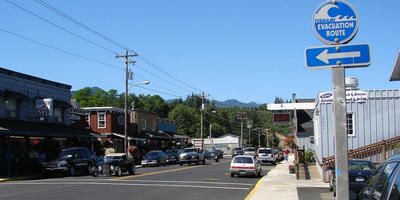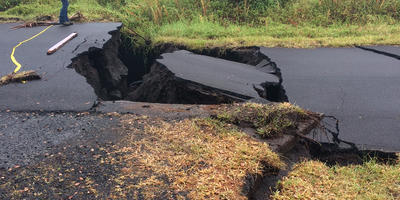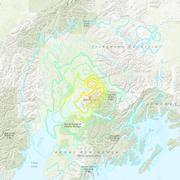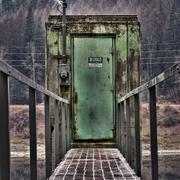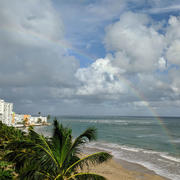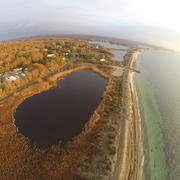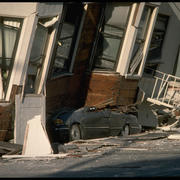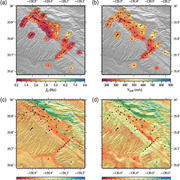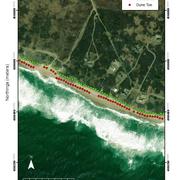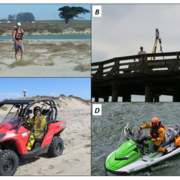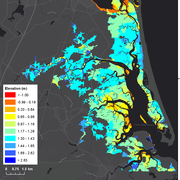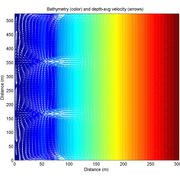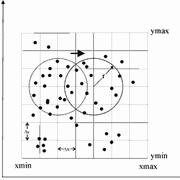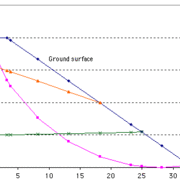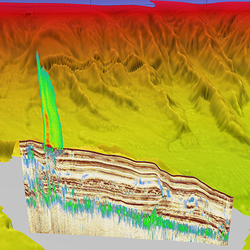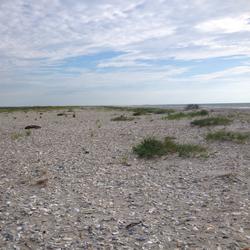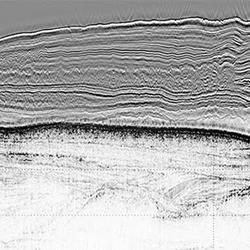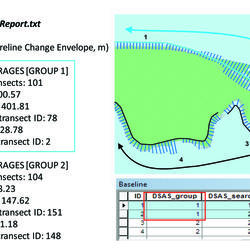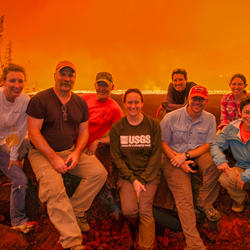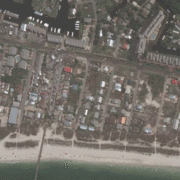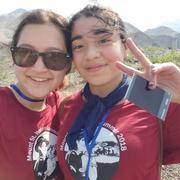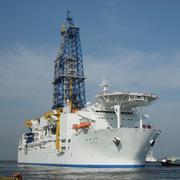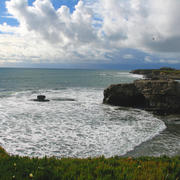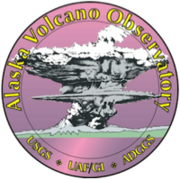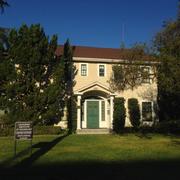Mission Areas
Natural Hazards
Mission Areas L2 Landing Page Tabs
Every year in the United States, natural hazards threaten lives and livelihoods and result in billions of dollars in damage. We work with many partners to monitor, assess, and conduct targeted research on a wide range of natural hazards so that policymakers and the public have the understanding they need to enhance preparedness, response, and resilience.
Read Our Science StrategyCosts and consequences of natural hazards can be enormous; each year more people and infrastructure are at risk. We develop and apply hazards science to help protect U.S. safety, security, and economic well being. These scientific observations, analyses, and research are crucial for the Nation to become more resilient to natural hazards.
Read Our Science StrategyHurricane Sandy Response- Linking the Delmarva Peninsula's Geologic Framework to Coastal Vulnerability
The Delmarva Peninsula is a 220-kilometer-long headland, spit, and barrier island complex that was significantly affected by Hurricane Sandy. In order to better constrain controls on coastal vulnerability and evolution, the region’s sediment sources, transport pathways and sinks must be identified. This project defines the geologic framework of the Delmarva coastal system through geophysical...
San Francisco Bay Area - East Bay (BALT1) Site near Castro Valley, CA
Recent Conditions
The instruments were installed in the spring of 2009 and are used to monitor and detect changes in local conditions. Soil water content and ground water pressure are monitored at two nests on the same hillslope. Data for the site include:
- Rainfall ...
Using Video Imagery to Study Wave Dynamics: Isla Verde
Four video cameras overlook the coast at Isla Verde in San Juan, Puerto Rico. Two of them focus on the shoreline: Camera 1 looks at the nearby beach and eastward along the shore, and Camera 2 looks farther away to the eastern end of the beach. The other two look out across the reefs: Camera 3 to the north-northwest, and Camera 4 to the northeast.
Environmental Geochemistry- Coastal Aquifers, Wetlands, and Tidal Exchange
The interface between groundwater and the coastal or intertidal landscape determines the location and migration path of fresh and saline wetlands. These ecosystems interact with the coastal ocean in many ways, much of which is driven by tidal exchange and groundwater discharge, both common coastal processes that deliver water, nutrients, and other materials to nearshore ecosystems, including...
Environmental Geochemistry- Wetland Resilience
Tidal wetlands are key ecosystems because they are unique ecological systems that provide essential habitat for fish, shellfish, birds and other fauna and flora, many of which have great economic importance. At the same time, tidal wetlands provide critical services to society by serving as a physical barrier between our cities, roads and homes and the rising sea. If healthy and properly...
Environmental Geochemistry- Managed Wetlands
The challenge of wetland persistence is complicated by widespread management and alteration of wetland hydrology, and built infrastructure within migration corridors. Human development and utilization of coastal landscapes in the U.S. during the past several centuries has resulted in loss of approximately half of tidal wetland area, largely due to 1) restriction of tidal flows, through...
Environmental Geochemistry
Coastal Environmental Geochemistry research at the Woods Hole Coastal and Marine Science Center spans multiple ecosystems and topics, including coastal wetlands, aquifers, and estuaries, with the goal of providing data and guidance to federal, state, local, and private land owners and managers on these vital ecosystems.
Remote Sensing Coastal Change
We use remote-sensing technologies—such as aerial photography, satellite imagery, and lidar (laser-based surveying)—to measure coastal change along U.S. shorelines.
California Seafloor Mapping Program data collection
Here we describe the data collection methods and techniques of the California Seaflor Mapping Program: mapping, video and photography ground-truthing, and seismic profiling data collection.
California Seafloor Mapping Program map-set production
USGS and the California Ocean Protection Council (COPC) are supporting development of peer-reviewed map sets for California’s mainland State Waters.
Global Geoengineering Research: Methods of study
Field methods of study in global geoengineering research
Global Geoengineering Research: Modeling
Prediction of the severity of ground failure in Quaternary deposits is a critical component of hazard studies. Model development in our project is focused on design and application of methods for quantitative assessment of ground deformation potential.
Conceptual marsh units for Fire Island National Seashore and central Great South Bay salt marsh complex, New York
The salt marsh complex of Fire Island National Seashore (FIIS) and central Great South Bay was delineated to smaller, conceptual marsh units by geoprocessing of surface elevation data. Flow accumulation based on the relative elevation of each location is used to determine the ridge lines that separate each marsh unit.
Dune Metrics for the Massachusetts Coast as Derived From 2013–14 Topographic Lidar Data
This data release, which is part of the 2018 update, defines the position and elevation of the most seaward dune crest and toe along the Massachusetts coast as derived from 2013–14 lidar data. In the absence of a dune, the peak of the berm or the seaward edge of a bluff, headland, or hard structure (for example, a seawall, road, or parking lot) was chosen as a proxy for the dune crest.
High-resolution geophysical data collected in Lake Powell, Utah-Arizona, U.S. Geological Survey Field Activity 2017-049-FA
High-resolution geophysical mapping of Lake Powell in the Glen Canyon National Recreation Area in Utah and Arizona was conducted between October 8 and November 15, 2017, as part of a collaborative effort between the U.S. Geological Survey and the Bureau of Reclamation to provide high-quality data needed to reassess the area-capacity tables for the Lake Powell reservoir.
Mean tidal range in marsh units of Assateague Island National Seashore and Chincoteague Bay, Maryland and Virginia
This dataset displays the spatial variation of mean tidal range (i.e. Mean Range of Tides, MN) in the Assateague Island National Seashore and Chincoteague Bay based on conceptual marsh units defined by Defne and Ganju (2018). MN was based on the calculated difference in height between mean high water (MHW) and mean low water (MLW) using the VDatum (v3.5) database (...
Unvegetated to vegetated marsh ratio in Assateague Island National Seashore and Chincoteague Bay, Maryland and Virginia
Unvegetated to vegetated marsh ratio (UVVR) in the Assateague Island National Seashore and Chincoteague Bay is computed based on conceptual marsh units. The response and resilience of coastal wetlands to physical factors need to be assessed in terms of the ensuing change to their vulnerability and ecosystem services.
Elevation of marsh units in Assateague Island National Seashore and Chincoteague Bay, Maryland and Virginia
Elevation distribution in the Assateague Island National Seashore (ASIS) salt marsh complex and Chincoteague Bay is given in terms of mean elevation of conceptual marsh units. The response and resilience of coastal wetlands to physical factors need to be assessed in terms of the ensuing change to their vulnerability and ecosystem services.
Conceptual marsh units for Assateague Island National Seashore and Chincoteague Bay, Maryland and Virginia
The salt marsh complex of Assateague Island National Seashore (ASIS) and Chincoteague Bay was delineated to smaller, conceptual marsh units by geoprocessing of surface elevation data. Flow accumulation based on the relative elevation of each location is used to determine the ridge lines that separate each marsh unit while the surface slope is used to automatically assign each unit a drainage...
Beach topography and nearshore bathymetry of northern Monterey Bay, California
This data release presents beach topography and nearshore bathymetry data from repeated surveys in northern Monterey Bay, California to document changes in shoreline position and coastal morphology as they relate to episodic (storms), seasonal, and interannual and longer processes. Since October 2014, semi-annual surveys have been performed in late summer (September or October...
Mean tidal range in marsh units of Plum Island Estuary and Parker River salt marsh complex, Massachusetts
This dataset displays the spatial variation of mean tidal range (i.e. Mean Range of Tides, MN) in the Plum Island Estuary and Parker River (PIEPR) salt marsh complex based on conceptual marsh units defined by Defne and Ganju (2018). MN was based on the calculated difference in height between mean high water (MHW) and mean low water (MLW) using the VDatum (v3.5) database.
Unvegetated to vegetated marsh ratio in Plum Island Estuary and Parker River salt marsh complex, Massachusetts
Through scientific efforts initiated with the Hurricane Sandy Science Plan, the USGS has been expanding national assessment of coastal change hazards and forecast products to coastal wetlands, including the Plum Island Estuary and Parker River salt marsh complex, with the intent of providing Federal, State, and local managers tools to estimate the vulnerability and ecosystem service potential...
Elevation of marsh units in Plum Island Estuary and Parker River salt marsh complex, Massachusetts
This data release provides elevation distribution in the Plum Island Estuary and Parker River (PIEPR) salt marsh complex. Elevation distribution was calculated in terms of mean elevation of conceptual marsh units. The elevation data was based on the 1-meter gridded Digital Elevation Model and supplemented by 1-meter resampled 1/9 arc-second resolution National Elevation Data, where data gaps...
Conceptual marsh units for Plum Island Estuary and Parker River salt marsh complex, Massachusetts
The salt marsh complex of Plum Island Estuary and Parker River was delineated to smaller, conceptual marsh units by geoprocessing of surface elevation data. Flow accumulation based on the relative elevation of each location was used to determine the ridge lines that separate each marsh unit while the surface slope was used to automatically assign each unit a drainage point, where water drains...
Seabed maps showing topography, ruggedness, backscatter intensity, sediment mobility, and the distribution of geologic substrates in Quadrangle 6 of the Stellwagen Bank National Marine Sanctuary Region offshore of Boston, Massachusetts
The U.S. Geological Survey (USGS), in cooperation with the National Oceanic and Atmospheric Administration's National Marine Sanctuary Program, has conducted seabed mapping and related research in the Stellwagen Bank National Marine Sanctuary (SBNMS) region since 1993.
Earthquake outlook for the San Francisco Bay region 2014–2043
Using information from recent earthquakes, improved mapping of active faults, and a new model for estimating earthquake probabilities, the 2014 Working Group on California Earthquake Probabilities updated the 30-year earthquake forecast for California. They concluded that there is a 72 percent probability (or likelihood) of at least one earthquake of magnitude 6.7 or greater striking somewhere in
Digital database of recently active traces of the Hayward Fault, California
This map shows the location of and evidence for recent movement on active fault traces within the Hayward Fault Zone, California.
HayWired aftershock (M> 5) ShakeMaps
The maps in this archive display estimated intensities and ground motions for the largest earthquakes in the HayWired aftershock sequence. The aftershock sequence follows the HayWired M7.0 mainshock that is imagined to occur on April 18, 2018 along the Hayward Fault.These maps have been used in analyses of the HayWired scenario.
Ground motion and regional information of the M 7.0 mainshock
The HayWired scenario depicts a hypothetical M7.0 earthquake on California’s Hayward Fault. This site includes an interactive map showing fault traces and ShakeMap contours, information on the tectonic setting of the Hayward Fault and fault rupture history; and a USGS ShakeMap, which provides ground motion information for the HayWired scenario mainshock.
The HayWired Scenario: An Urban Earthquake in a Connected World - A Geonarrative
What might it be like the next time the Hayward Fault has a large earthquake? A geonarrative and related imagery examines a hypothetical earthquake, the magnitude 7.0 HayWired earthquake scenario.
Regional Conductivity Maps
Location of 1D Earth Resistivity Models with respect to Physiographic Regions of the USA
Data from Earthquake-Induced Landslide Hazards for a M7.0 Scenario Earthquake on the Hayward Fault
The seismic-landslide probability map covers the counties of Alameda, Contra Costa, Marin, Napa, San Francisco, San Mateo, Santa Clara, Santa Cruz, Solano, and Sonoma. The slope failures are triggered by a hypothetical earthquake with a moment magnitude of 7.0 occurring on April 18, 2018, at 4:18 p.m. on the Hayward Fault in the east bay part of California’s San Francisco Bay region.
Map of America's Submerged Lands
Links to publications that contain maps of the sea floor or lake beds and the digital data used to create them.
Coastal and Marine Geology Program Interactive Maps
This portal is a “go to” source for maps related to ocean and coastal mapping. Information is organized by geography or region, by theme, and by the year data was published.
Interactive Flood Map
Maps of flood and high flow conditions within the U.S.
Honolulu Magnetic Observatory
Tucked in a grove of thorny mesquite trees, on an ancient coral reef on the south side of the Hawaiian island of Oahu, west of Pearl Harbor, a small unmanned observatory quietly records the Earth’s time-varying magnetic field. The Honolulu Magnetic Observatory is 1 of 14 that the U.S. Geological Survey Geomagnetism Program operates at various...
Love, Jeffrey J.; Finn, Carol A.Image mosaic and topographic maps of Mercury
Map DescriptionsSheet 1: This image mosaic is based on observations acquired by the Mercury Dual Imaging System (MDIS; Hawkins and others, 2009), an instrument on the National Aeronautics and Space Agency (NASA) MErcury Surface, Space ENvironment, Geochemistry, and Ranging (MESSENGER) spacecraft (Solomon and others, 2007). The Mercator projection...
Hunter, Marc A.; Hare, Trent M.; Hayward, Rosalyn K.; Chabot, Nancy L.; Hash, Christopher D.; Denevi, Brett W.; Ernst, Carolyn M.; Murchie, Scott L.; Blewett, David T.; Malaret, Erick R.; Solomon, Sean C.; Becker, Kris J.; Becker, Tammy L.; Weller, Lynn A.; Edmundson, Kenneth L.; Neuman, Gregory A.; Mazarico, Erwan; Perry, Mark E.Ground motions from the 7 and 19 September, 2017 Tehuantepec and Puebla-Morelos, Mexico, earthquakes
The 2017 M">M 8.2 Tehuantepec and M">M 7.1 Puebla‐Morelos earthquakes were deep inslab normal‐faulting events that caused significant damage to several central‐to‐southern regions of Mexico. Inslab earthquakes are an important component of seismicity and seismic hazard in Mexico. Ground‐motion prediction equations (GMPEs...
Sahakian, Valerie J.; Melgar, Diego; Quintanar, Luis; Ramirez-Guzman, Leonardo; Pérez-Campos, Xyoli; Baltay, Annemarie S.Tropical storm-induced landslide potential using combined field monitoring and numerical modeling
When heavy rainfall, such as that associated with tropical storms, falls on steep hillsides, shallow landslides are often one of the damaging consequences. To assess landslide potential from heavy rainfall, a strategy of combined numerical simulation and field monitoring of variably saturated hillslope conditions is developed. To test the combined...
Chen, Pan; Lu, Ning; Formetta, Giuseppe; Godt, Jonathan W.; Wayllace, AlexandraClimate dictates magnitude of asymmetry in soil depth and hillslope gradient
Hillslope asymmetry is often attributed to differential eco‐hydro‐geomorphic processes resulting from aspect‐related differences in insolation. At midlatitudes, polar facing hillslopes are steeper, wetter, have denser vegetation, and deeper soils than their equatorial facing counterparts. We propose that at regional scales, the magnitude in...
Inbar, Assaf; Nyman, Petter; Rengers, Francis K.; Lane, Patrick N. J.; Sheridan, Gary J.Mars global digital dune database (MGD3)—Composition, stability, and thermal inertia
The Mars Global Digital Dune Database (MGD3) is an online repository that has catalogued dune fields larger than 1 km2 located between latitudes 90° N. and 90° S. The work presented here expands upon previous MGD3 open-file reports, with a new emphasis upon characterizing dune fields through composition, stability, and thermal inertia. Included in...
Gullikson, Amber L.; Hayward, Rosalyn K.; Titus, Timothy N.; Charles, Heather; Fenton, Lori K.; Hoover, Rachael H.; Putzig, Nathaniel E.Development of a geodetic component for the U.S. West Coast Earthquake Early Warning System
An earthquake early warning (EEW) system, ShakeAlert, is under development for the West Coast of the United States. This system currently uses the first few seconds of waveforms recorded by seismic instrumentation to rapidly characterize earthquake magnitude, location, and origin time; ShakeAlert recently added a seismic line source algorithm. For...
Murray, Jessica R.; Crowell, Brendan W.; Grapenthin, R.; Hodgkinson, Kathleen; Langbein, John O.; Melbourne, Timothy; Melgar, Diego; Minson, Sarah E.; Schmidt, David A.Reported investments in earthquake mitigation top $73 to $80 billion in the San Francisco Bay Area, California, since the 1989 Loma Prieta earthquake
The purpose of this report is to provide a compilation of structural retrofits and replacements of older buildings and infrastructure in the San Francisco Bay Area that have either been completed since 1989 or that are in progress as of October 2018. For the purposes of this report, all or parts of nine Bay Area counties were included:...
Brocher, Thomas M.; Gefeke, Kerri; Boatwright, John; Knudsen, Keith L.Erratum to The 2013–2016 induced earthquakes in Harper and Sumner Counties, southern Kansas
The authors identified two sets of minor errors in the paper by Rubinstein et al. (2018), which are corrected here.
Rubinstein, Justin L.; Ellsworth, William L.; Dougherty, Sara L.Interseismic ground deformation and fault slip rates in the greater San Francisco Bay Area from two decades of space geodetic data
The detailed spatial variations of strain accumulation and creep on major faults in the northern San Francisco Bay Area (North Bay), which are important for seismic potential and evaluation of natural hazards, remain poorly understood. Here we combine interferometric synthetic aperture radar data from the ERS‐1/2 and Envisat satellites between...
Wu, Songbo; Nadeau, Robert; Ding, Xiaoling; Xu, Wenbin; Wu, Songbo; Materna, Kathryn; Nadeau, Robert; Floyd, Michael; Funning, Gareth J.; Chaussard, Estelle; Johnson, Christopher W.; Murray, Jessica R.; Ding, Xiaoling; Burgmann, RolandImproving earthquake rupture forecasts using California as a guide
This article discusses ways in which earthquake rupture forecast models might be improved. Because changes are most easily described in the context of specific models, the third Uniform California Earthquake Rupture Forecast (UCERF3) and its presumed successor, UCERF4, is used as a basis for discussion. Virtually all of the issues and possible...
Field, Edward H.VS30 at three strong-motion recording stations in Napa and Solano Counties, California—Lovall Valley Road, Broadway Street and Sereno Drive in Vallejo, and Vallejo Fire Station—Calculations determined from S-wave refraction tomography and multichannel analysis of surface waves (Rayleigh and Love)
The August 24, 2014, moment magnitude (Mw) 6.0 South Napa earthquake caused an estimated $400 million in structural damage to the City of Napa, California. In 2015, we acquired high-resolution P- and S-wave seismic data near three strong-motion recording stations in Napa and Solano Counties where high peak ground accelerations (PGAs) were recorded...
Chan, Joanne H.; Catchings, Rufus D.; Goldman, Mark R.; Criley, Coyn J.SEA-MAT: Matlab Tools for Oceanographic Analysis
A collaborative effort to organize and distribute Matlab tools for the Oceanographic Community
bi-transect-extractor
This package is used to calculate coastal geomorphology variables along shore-normal transects. The calculated variables are used as inputs for modeling geomorphology using a Bayesian Network (BN).
iPlover
iPlover was developed by the U.S. Geological Survey Woods Hole Coastal and Marine Science Center and the USGS Center for Integrated Data Analytics. It is used by trained and vetted personnel to record information about habitats on coastal beaches and he environment surrounding them.
THRESH
Software for tracking rainfall thresholds for landslide and debris-flow occurrence, user manual.
Earthquake Software
Designed to facilitate the study of earthquakes, faults, and seismic related events.
Landslide software
Various software designed for landslide assessments and modeling.
Scoops3D
Scoops3D is software to analyze three-dimensional slope stability throughout a digital landscape.
SLAMMER
SLAMMER is a Java program that facilitates performing a variety of sliding-block analyses to evaluate seismic slope performance.
TRIGRS
A Fortran Program for Transient Rainfall Infiltration and Grid-Based Regional Slope-Stability Analysis, Version 2.0.
PTCOUNT
A Fortran-77 Computer Program to Calculate the Areal Distribution of Mapped Data Points Using Count-Circle Methodology.
JanbuGS, BishopGS, and FelleniusGS
Fortran-77 programs for limit-equilibrium slope-stability analysis.
The Bay Bridge and the Oakland city skyline
The nighttime Oakland city skyline as seen from San Francisco with the Bay Bridge in the foreground
Water Column and Seismic collage
3D Image of a multi-channel seismic (MCS) line showing gas (blue/green) migrating up through fractures in the subsurface, culminating in a 600 meter tall plume of methane gas in the water column that was captured using a Simrad EK60 split beam echo sounder. Background bathymetry was downloaded from USGS Open-File Report 2012-1266 (
...Three-dimensional model of Chimney Bluffs, New York along Lake Ontari
Three-dimensional model of Chimney Bluffs, New York along Lake Ontario created from low-altitude digital images collected from an unmanned aerial system (UAS).
Displaying fixed bin options for rates of change
Displaying fixed bin options (left) for rates of change for an example dataset (LRR, EPR, WLR), and scaled to data (right) (NSM).
Piping Plover Habitat, Cedar Island
The beach-dependent shorebirds project at the Woods Hole Coastal and Marine Science Center models current and future habitat availability for nesting shorebirds in an effort to map current and likely future habitat availability on a range of sites along the U.S. Atlantic coast. Sites include beaches with minimal human-presence, such Cedar Island shown here off of the
...Data visualization with scaled options applied
Data visualization with (A) fixed and (B) scaled options applied. Examples of NSM and SCE are also displayed (C and D respectively). The data itself has not changed – only the scaling and statistic selected through the DSAS Data Visualization tool.
Seismic Collage
Image showing a collage of examples of multi-channel and single-channel seismic data collected by the USGS, seismic equipment deployed from a research vessel, and seismic equipment on a research vessel. These data are critical to the CMG Program as they define the geology in marine and coastal environments.
DSAS Summary Report
Example of a section of DSAS summary report highlighting the use of DSAS_group to organize output statistics.
ShakeAlert sensor station being serviced by USGS personnel
A USGS electronics technician performs maintenance on a ShakeAlert Earthquake Early Warning (EEW) sensor station, located in the San Francisco Bay Area. ShakeAlert station components include strong-motion accelerometers, solar panel and battery power systems, and communications & telemetry equipment for communication with the wider ShakeAlert network.
UAS pilots at Kilauea
Department of Interior UAS pilots from left to right – Elizabeth Pendleton (USGS, Woods Hole, MA), Colin Milone (Office of Aviation Services, AK), John Vogel (USGS; Flagstaff, AZ), Sandy Brosnahan (USGS, Woods Hole, MA), Brandon Forbes (USGS; Tuscon, AZ), Chris Holmquist-Johnson
...Screenshot of Our Coast, Our Future
Screenshot of Our Coast, Our Future (OCOF) interactive map view of Stinson Beach, California, showing extent of flooding predicted if subjected to a sea-level rise of 100 centimeters (about 40 inches) and elevated water levels caused by a 100-year storm.
SEABOSS Collage
SEABed Observation and Sampling System (SEABOSS) (center image) and the MiniSEABOSS (right) designed for rapid, inexpensive, and effective collection of seabed imagery (photographs and video) as well sediment samples from the coastal/inner-continental shelf regions. Images from coastal Massachusetts show purple algae-encrusted cobbles and boulders covered with sea-stars (
...2018 Anchorage Earthquake
A magnitude 7.0 earthquake struck north of Anchorage, Alaska, on November 30, 2018, at 8:29 a.m. local time (17:29:28 UTC). This is a developing story, so please keep checking for updates.
The Woods Hole Coastal and Marine Science Center Aerial Imaging and Mapping Group Aids in Monitoring and Mapping the Kīlauea Volcanic Eruption
On May 3, 2018, Kīlauea, one of the world’s most active volcanoes, began an over three-month-long eruption. Tina Neal and the rest of her team at the U.S. Geological Survey Hawaiian Volcano Observatory (HVO) have been spearheading all Kīlauea monitoring and data-analysis efforts, and continue to provide regular updates on the status...
USGS Working to Restore Streamgages
For questions about a streamgage in your state, please contact your local USGS water science center; contacts can be found at https://water.usgs.gov/key_officials.html.
Before and After: Coastal Change Caused by Hurricane Michael
To learn more about USGS’ role providing science to decision makers before, during and after Hurricane Michael, visit the USGS Hurricane Michael page at https://usgs.gov/hurricane-michael.
The Hayward Fault—Is It Due for a Repeat of the Powerful 1868 Earthquake?
By Thomas M. Brocher, Jack Boatwright, James J. Lienkaemper, Carol S. Prentice, David P. Schwartz, and Howard Bundock
Drawn from: USGS Fact Sheet 2018-3052
The Great ShakeOut! -- 2018 Edition
Do you know what to do the moment the ground starts shaking? Drop, Cover, and Hold On!
GeoGirls Rock! USGS women encourage and support the next generation of scientists
Mount St. Helens volcano loomed in the distance as 25 middle-school “GeoGirls” signed in, received a name tag, dropped their overnight gear and gathered in a grassy open space to meet camp staff, women scientists and volunteers.
National Earthquake Information Center (NEIC) Leads Meeting on the Future of Earthquake Research and Monitoring
What are the next goals for the NEIC?
USGS scientists provide input for workshop on scientific drilling targets in the north Pacific Ocean
Pacific Coastal and Marine Science Center research geologist Danny Brothers attended the International Ocean Discovery Program (IODP) workshop on the “Scientific Exploration of the Arctic and North Pacific” September 25–27 in Mt. Hood, Oregon.
USGS: Hurricane surge likely to erode 75% of Florida Panhandle beaches
One-fourth of beachfront could be inundated by large storm waves, experts predict
To learn more about USGS’ role providing science to decision makers before, during and after Hurricane Michael, visit the USGS Hurricane Michael page at usgs.gov/hurricane-michael.
USGS: Hurricane surge likely to erode 75% of Florida Panhandle beaches
One-fourth of Florida Panhandle beachfront could be inundated by large storm waves, experts predict
To learn more about USGS’ role providing science to decision makers before, during and after Hurricane Michael, visit the USGS Hurricane Michael page at https://usgs.gov/hurricane-michael
Large underwater experiment in Monterey Canyon shows turbidity currents involve seafloor movement
Large underwater experiment in California’s Monterey Canyon shows that “turbidity currents” are not just currents, but involve movement of the seafloor itself.


